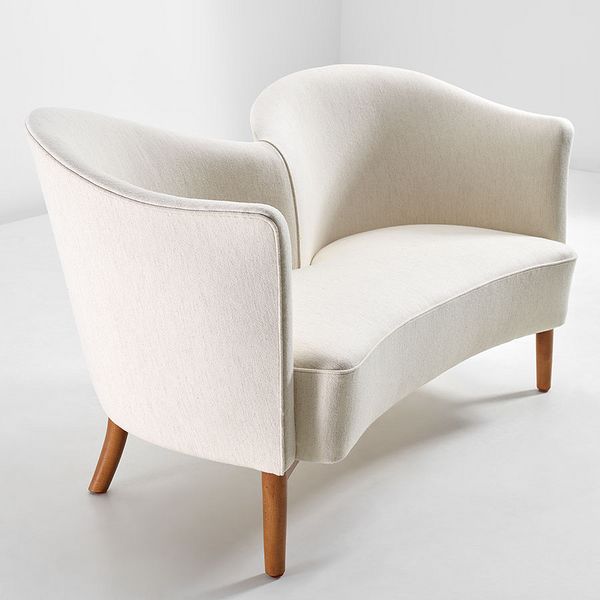Nanna and Jørgen Ditzel, Rare two-seater sofa, 1949. Design London.
PHILLIPS: What were Nanna and Jørgen Ditzel’s inspirations for their designs?
DENNIE DITZEL: My parents inspired one another and worked together to produce pieces that they thought were needed at the time. They developed and created furniture that they themselves would use. Every year, they participated in the Cabinetmakers’ Guild exhibition which was a significant commitment as entire furniture sets had to be designed and executed.
Nanna was particularly inspired by the height of spaces and cared to utilise the cubic meters available, rather than just the square meters of a room. One evening in 1952, as they thought about how to move away from conventional furniture design, Nanna and Jørgen counted the feet of all the furniture in their living room and reached a number close to fifty. They then climbed onto the dining table and realised everything looked different from that vantage point. This inspired their seating arrangement experiment where they used the entire dimensions of a room to create a stepped environment made from foam-rubber elements. The upholstered steps could accommodate a variety of molded foam furniture and gave people different perspectives from within the same room. Their installation was exhibited at Winkel & Magnussen in central Copenhagen.
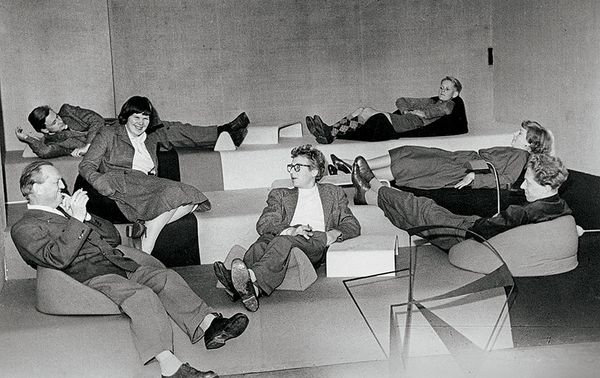
The seating arrangement experiment designed by Nanna and Jørgen Ditzel in 1952. Nanna Ditzel on the far right in the middle row, Jørgen Ditzel on the far right. Knud Willadsen on the far left on the bottom row. Photo: Nanna Ditzel Design.
DD: They also found design cues from their travels. Nanna lived in London for 18 years and spent some time in Trinidad and Tobago where the railings on houses and the colonial style architecture inspired her to create outstanding combinations of shapes and patterns such as the Trinidad Chair.
P: What might have been the starting point for the design of this rare sofa and the striking shape of its backrest?
DD: Nature was an important source of creativity for my parents, which influenced their use of organic shapes. Nanna used to say: “Look out into nature, there are no right angles!”. They also believed that their designs went beyond the categorization of Danish design as solely minimalist.
Look out into nature, there are no right angles! – Nanna Ditzel
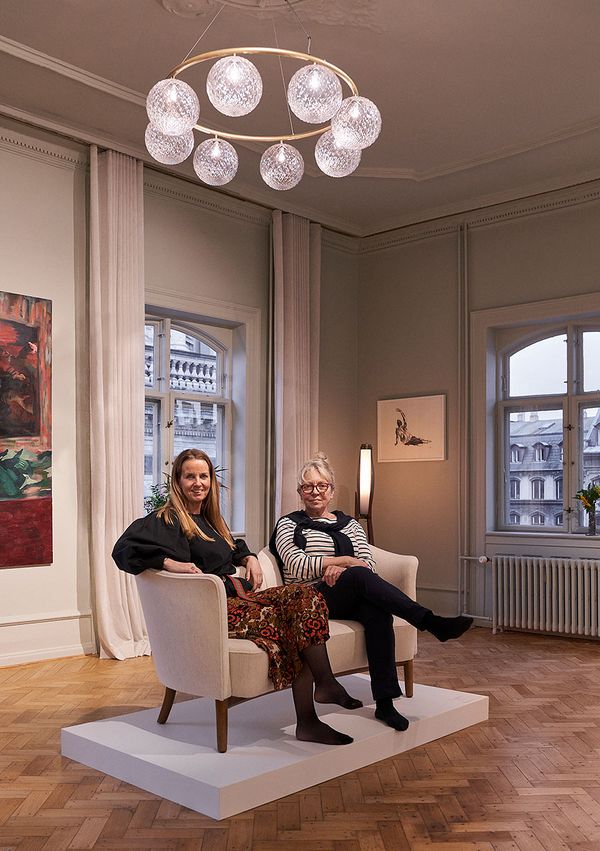
Dennie Ditzel and Kirsten MacDonald at the Phillips preview in Copenhagen. Credit: Emil Vendelbo Stegemejer / Yellows Studio.
P: Many of Nanna’s pieces are now recognizable designs while this sofa is a rare early gem. Do you know why it was not put into larger production?
DD: I wonder why this sofa didn’t make it into a larger production. Perhaps it was Knud Willadsen, the cabinetmaker who executed many of their sofas, who decided this; it could also have been too expensive to make or maybe the upholstery seemed complicated. The sofa was executed by master cabinetmaker Knud Willadsen and I believe that less than ten pieces were ever made.
P: Did Nanna and Jørgen have a view about the role of furniture design in society?
DD: Yes, they did. To them, it was essential that form and function complement each other. Aesthetics were a priority, but they also strived to create pieces that could improve lives and enhance surroundings. My parents cared deeply about making furniture that was at once useful and beautiful to look at.
P: Could you tell us about their joint design process?
DD: My parents collaborated closely and developed their thoughts together. One would take over when the other stopped. Jørgen taught at the School of Interior Design in Copenhagen (led by Finn Juhl and where Bodil Kjær was one of Jørgen’s students). Designing was a shared and hands-on experience for them. They made sketches which later became models. These were mostly small paper models glued together or made from modelled wax which they then mocked up in real size (using either cardboard, tubes, or wood). They went through all these steps very thoroughly, supporting each other. If one ran out of steam, then the other would bring fresh eyes to move the project or idea along.

Nanna and Jørgen Ditzel working together, circa 1955-56 Photo: Nanna Ditzel Design.
P: Nanna has talked about the importance of her surroundings and observations on her designs. Do you have memories of your parents at work?
DD: Yes, I have memories of my parents’ working process. Nanna saved all their sketches. On the front, they described projects such as: "wooden chair," "experiments with thin veneer," "millings," et cetera. It was a detailed script which included her thoughts, defining how the piece would act as a sculpture and function in the room. One example might be "room for two, good dialogue." It could also include thoughts about testing different wood types and experimenting with veneer. Every design was carefully written up before moving into the production phase.
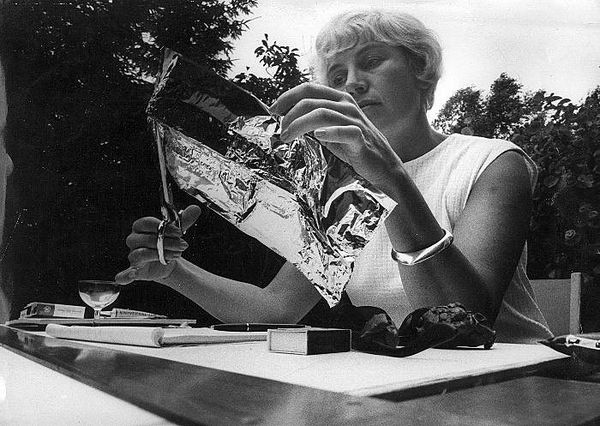
Nanna’s hands-on design process, circa 1965-66. Photo: Nanna Ditzel Design.
P: Nanna has also talked about her desire to create furniture that transcended the functional. This piece seems to be a poetic iteration of that desire to express emotion beyond function in her pieces. What are your thoughts on this higher vision for furniture that your mother had?
DD: I think it can be linked back to their design education. Kaare Klint defined the development of Danish furniture design at that time, where function was in the forefront. Yet my parents were big believers that furniture needed to come alive through its shape. The definition of their own design language was enormously important to them. Take for example the jewellery that Nanna loved making. She used to say, "You only design jewellery if the shape is striking." I asked her once, if she had not become what she became, what would she have chosen? She replied: “Sculptor!” The crafting of beautiful shapes was paramount to her and she often said that it would hurt her soul if something didn’t look beautiful.
P: Does this sofa have a name?
DD: No, it doesn’t. Nanna didn’t tend to name her pieces; rather the cabinetmaker gave them numbers. To me, it was always the Heart Sofa. This is the first time I see it in the flesh, as I’ve only seen it from literature in the past!
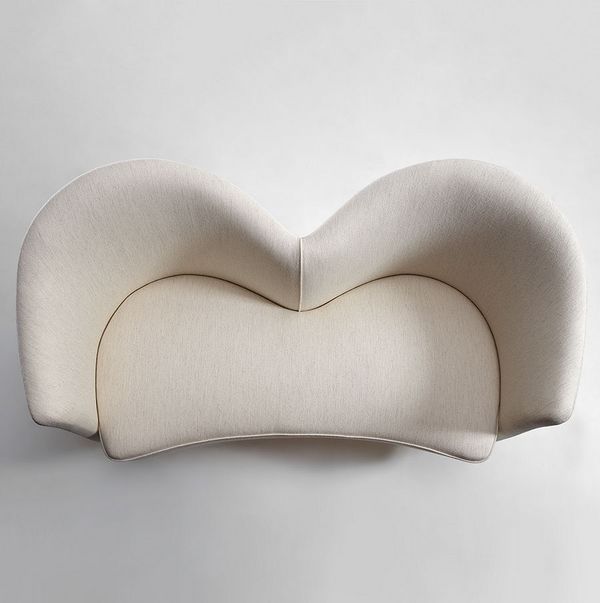
Nanna and Jørgen Ditzel, Rare two-seater sofa, 1949. Design London.
Recommended Reading
